Neck Warts: Uncovering the Mystery Behind These Skin Growths

- Understanding Warts: Small, Benign Growths
- Human Papillomavirus (HPV): The Root Cause
- Skin-to-Skin Contact: HPV Transmission
- Neck Warts: Common but Often Harmless
- Weakened Immune System: Increased Risk
- Shared Personal Items: Spreading the Virus
- Cuts or Breaks in Skin: Easy Entry Points
- Children and Teenagers: More Susceptible
- Types of Warts Found on the Neck
- Seeking Medical Advice for Diagnosis
- Treatment Options: Removing Warts Safely
- Preventing Neck Warts: Practical Tips
- Maintaining Good Hygiene: Crucial for Prevention
- Vaccination: Protecting Against HPV Strains
- Boosting Immunity: Lowering Your Risk
Understanding Warts: Small, Benign Growths
Warts are small, noncancerous growths that appear on the skin. They are caused by the human papillomavirus (HPV), which infects the top layer of skin. While warts can appear anywhere on the body, they are common on the hands, feet, and face. But what about warts on the neck?
The same principle applies to warts on the neck. Direct contact with HPV, either from an infected person or contaminated surfaces, is the primary culprit. This can happen through:
- Touching someone's wart
- Sharing personal items like towels or razors
- Scratching or picking at existing warts, which can spread the virus to other parts of the body
While anyone can get warts on their neck, some factors increase the risk:
- Weakened immune system: Individuals with compromised immune systems are more susceptible to HPV infection.
- Age: Children and teenagers are more prone to warts due to frequent skin-to-skin contact.
- Certain activities: Activities that involve close contact, such as wrestling or using shared gym equipment, can increase the risk of HPV transmission.
If you have a wart on your neck, it's essential to avoid picking or scratching it, as this can spread the virus. Most warts are harmless and go away independently, but it might take months or even years.
Human Papillomavirus (HPV): The Root Cause
Warts appearing on the neck, often referred to as skin tags or filiform warts, are primarily caused by the human papillomavirus (HPV). HPV is a common virus with numerous strains, some of which are responsible for these benign skin growths. While not all HPV strains cause warts, certain types, like HPV 1, 2, 4, 27, and 29, are known culprits for those appearing on the neck.
These warts are generally harmless and painless. HPV spreads through direct skin-to-skin contact or contact with infected surfaces. Tiny cuts or breaks in the skin can make it easier for the virus to enter and cause an infection. While anyone can get HPV, those with weakened immune systems might be more susceptible.
It's important to remember that warts on the neck are usually benign and don't pose a serious health risk. However, if you're concerned about any skin growths or notice changes in their appearance, it's always best to consult a dermatologist or healthcare professional for proper diagnosis and treatment.
Skin-to-Skin Contact: HPV Transmission
While skin-to-skin contact is a significant route of transmission for HPV, the virus that causes warts, it's less likely to be the primary reason for warts appearing specifically on the neck. Here's why:
HPV thrives in warm, moist environments, making areas like the genitals, hands, and feet more susceptible. The neck, while accessible, isn't as conducive to HPV transmission.
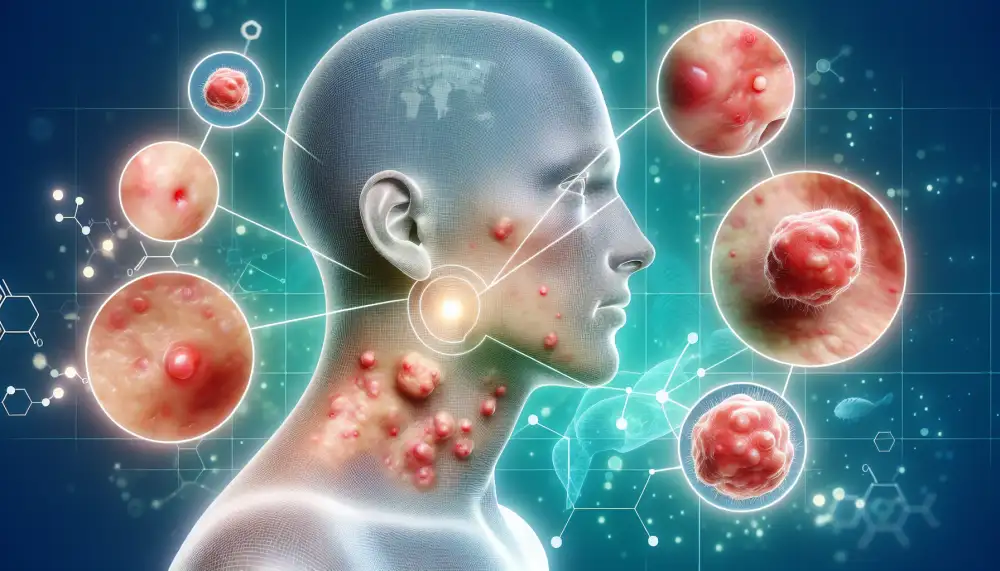
Warts on the neck, often referred to as "common warts," are typically caused by HPV types that are different from those associated with genital warts. These types are more likely to spread through direct contact with a wart or a contaminated surface, like towels or razors.
Scratching or picking at existing warts can also spread the virus to other parts of the body, including the neck.
While intimate contact can theoretically transmit HPV to the neck, it's essential to remember that HPV is incredibly common, and most people clear the infection without ever developing symptoms.
If you're concerned about warts on your neck or any unusual skin growths, consult a dermatologist or healthcare professional for proper diagnosis and treatment.
Neck Warts: Common but Often Harmless
Neck warts, while common, are usually harmless and caused by a viral skin infection called human papillomavirus (HPV). This virus causes an overgrowth of cells on the top layer of your skin, resulting in a wart. HPV is contagious and can spread through direct contact with an infected person or even by touching surfaces they've touched.
While anyone can get neck warts, some people are more susceptible, including children and teenagers, people with weakened immune systems, and those who have close contact with someone who has warts.
The appearance of neck warts varies. They can be small, flat, flesh-colored bumps or larger, raised growths that might be rough or cauliflower-like in texture. While they're usually painless, they can sometimes itch, bleed, or become irritated, especially if they rub against clothing or jewelry.
If you're concerned about warts on your neck, it's best to consult a dermatologist or healthcare professional for diagnosis and treatment options. They can determine the best course of action based on the size, location, and type of wart.
Weakened Immune System: Increased Risk
A weakened immune system can definitely make you more susceptible to HPV infections, which are the root cause of those pesky warts. When your body's defense system isn't in tip-top shape, it has a harder time fighting off the virus. This means HPV can take hold more easily and lead to warts, including those on the neck.
| Cause | Description | More Likely on Neck? |
|---|---|---|
| Human Papillomavirus (HPV) | A common virus that enters the body through tiny cuts or breaks in the skin. Different strains of HPV cause different types of warts. | Yes, some strains of HPV are more likely to cause warts on the neck and face. |
| Skin-to-skin contact | Warts are contagious and can spread through direct contact with an infected person or by sharing personal items. | Yes, neck-to-neck contact (like hugs) can spread the virus. |
| Weakened immune system | People with weakened immune systems are more susceptible to HPV infection and may develop warts more easily. | Potentially, as a weakened immune system makes any area more vulnerable. |
Several factors can compromise your immune system:
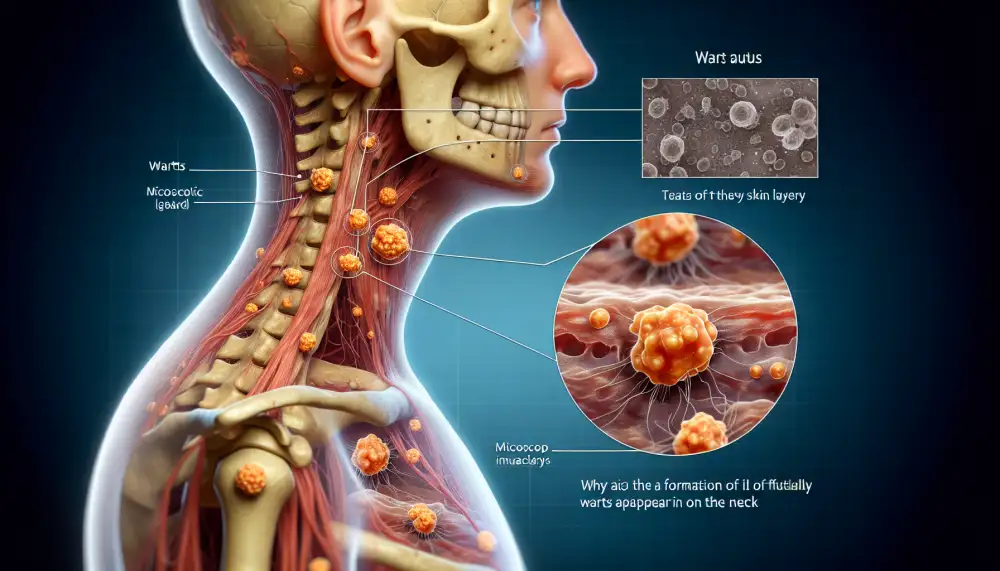
Medical conditions like HIV/AIDS or autoimmune disorders
Certain medications, such as immunosuppressants taken after organ transplants
Chemotherapy or radiation therapy for cancer treatment
Stress, lack of sleep, and poor nutrition
If you have a weakened immune system, you might notice warts appearing more frequently or taking longer to disappear. It's crucial to take extra precautions to prevent HPV infection, like practicing good hygiene and avoiding close contact with individuals who have warts. If you have any concerns about your immune health or the appearance of warts, don't hesitate to reach out to your doctor for personalized advice and treatment options.
Shared Personal Items: Spreading the Virus
Warts, including those that appear on the neck, are caused by the human papillomavirus (HPV). While some HPV types spread through sexual contact, others transmit through casual skin-to-skin contact or by sharing personal items. This is especially true for HPV types that cause common warts. Sharing objects like razors, towels, or even nail clippers can inadvertently spread the virus if the person you're sharing with has a wart. Even a small cut or abrasion on your skin can make you more susceptible to picking up the virus. Always avoid sharing personal items that come into contact with your skin, and be cautious about borrowing them from others.
Cuts or Breaks in Skin: Easy Entry Points
The skin is our body's first line of defense, acting as a barrier against harmful microorganisms. However, any cuts, scrapes, or breaks in this protective layer can create easy entry points for viruses, including the human papillomavirus (HPV), which causes warts.
Think of it like this: a cut or break in the skin is like an open door for germs. HPV can easily slip through these openings and infect the surrounding skin cells. This is especially true if the area is frequently touched or rubbed, as this can further irritate the skin and make it more susceptible to infection.
While HPV is most commonly associated with warts on the hands and feet, it can also cause warts on other parts of the body, including the neck. This is why it's essential to keep any cuts or breaks in the skin clean and covered, especially if you're prone to getting warts.
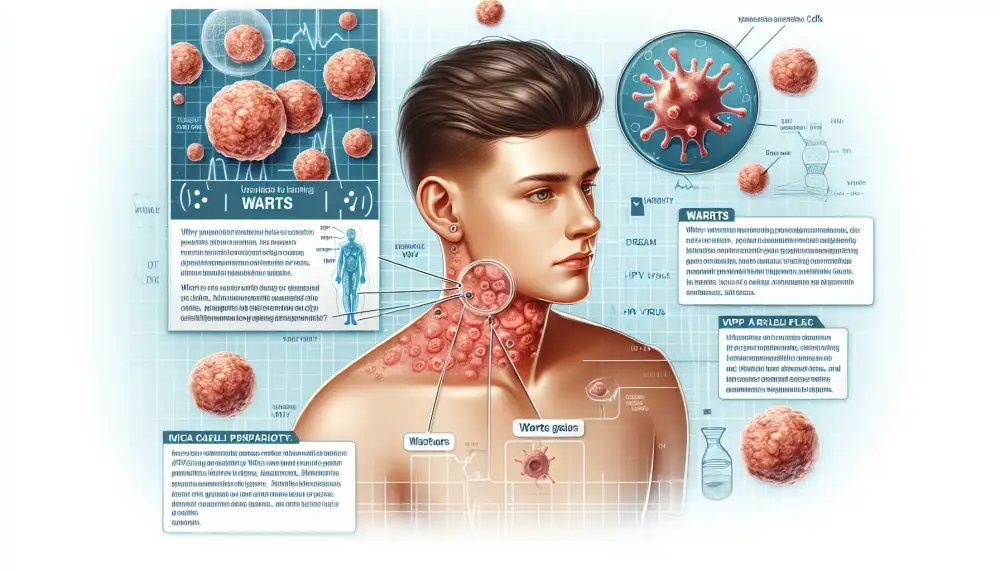
Children and Teenagers: More Susceptible
Children and teenagers often have more skin-to-skin contact than adults, especially during play and sports. This makes it easier for the virus to spread. Their immune systems are also still developing, making them more susceptible to infections like HPV, which can cause warts.
It's important to note that while some HPV types can cause warts on the neck, these are generally considered low-risk and are different from the types that cause more serious health concerns.
Types of Warts Found on the Neck
Warts are small, non-cancerous growths that appear on the skin due to the human papillomavirus (HPV). While they can occur anywhere on the body, they are common on the hands, feet, and face. Warts on the neck, while less common, can be equally bothersome. Understanding the types of warts that appear on the neck can help determine the appropriate treatment.
The most common type of wart found on the neck is the common wart, characterized by its rough, dome-shaped appearance. These warts are typically painless and flesh-colored or slightly darker. Another type is the flat wart, which, as the name suggests, is flat-topped and smoother than common warts. They are often smaller and can appear in clusters, making them more noticeable.
Filiform warts are another type that can occur on the neck, particularly around the eyelids and lips. These warts have a distinctive finger-like or thread-like appearance. While generally harmless, they can be irritating and may require treatment for cosmetic reasons.
The reason why warts appear on the neck, similar to other areas of the body, is due to HPV infection. The virus thrives in warm, moist environments, making areas like the neck susceptible, especially if there are cuts, scrapes, or breaks in the skin.
It's important to note that not everyone exposed to HPV develops warts. A healthy immune system can often fight off the virus. However, those with weakened immune systems or those who frequently touch their faces and neck may be more prone to developing warts in these areas.
Seeking Medical Advice for Diagnosis
While it's tempting to self-diagnose, seeing a doctor for neck growths is crucial. Here's why:
Accurate Diagnosis: Many skin conditions can resemble warts. A doctor can differentiate between warts, moles, skin tags, and other growths, ensuring appropriate treatment.
Determining the Cause: Warts stem from the human papillomavirus (HPV). A doctor can help identify potential sources of exposure and advise on preventing future outbreaks.
Safe and Effective Treatment: Doctors can offer various wart removal methods, like cryotherapy or prescription medications, considering your individual needs and medical history.
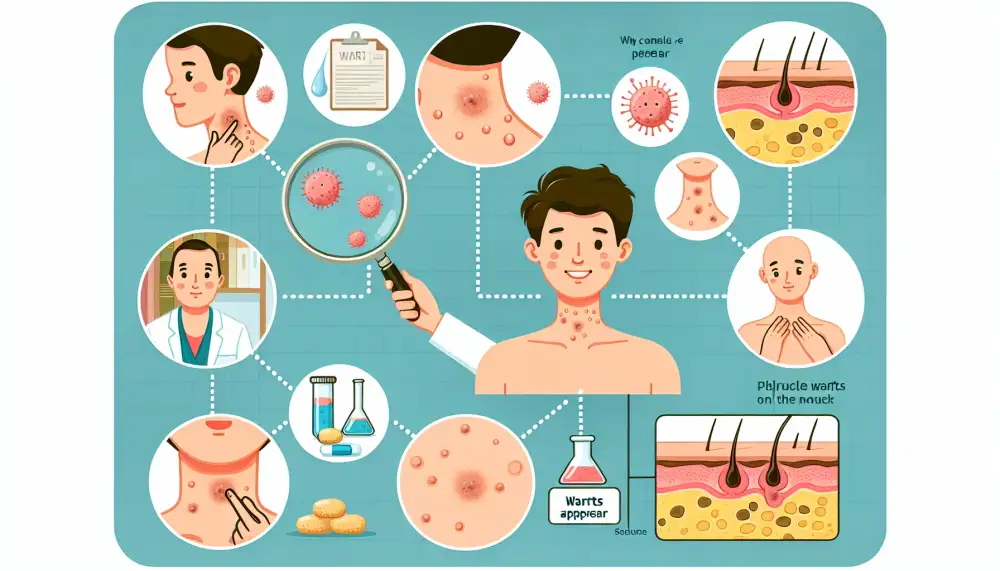
Addressing Underlying Issues: In rare cases, persistent warts or unusual presentations might signal an underlying health concern requiring further investigation.
Remember, seeking professional medical advice for any skin changes, especially those that are new, changing, or causing concern, is always the safest course of action.
Why do warts appear on the neck? This is a question that has puzzled dermatologists for years. There are many theories, but no one knows for sure. Some believe that it is caused by a virus, while others believe that it is a reaction to something in the environment. Whatever the cause, warts on the neck can be unsightly and embarrassing.
Dr. Evelyn Montgomery
Treatment Options: Removing Warts Safely
Warts on the neck, while usually harmless, can be bothersome. They're caused by the human papillomavirus (HPV), which enters the body through tiny cuts or breaks in the skin. While there's no single answer to why warts appear on the neck specifically, factors like close contact, weakened immunity, or even something as simple as touching your neck after touching a wart elsewhere can contribute.
Thankfully, there are various treatment options available to safely remove neck warts. It's crucial to consult a dermatologist to determine the best course of action for your specific case. They might recommend:
Topical medications: These are often the first line of treatment and contain ingredients like salicylic acid that help peel away the wart gradually.
Cryotherapy: This involves freezing the wart with liquid nitrogen, causing it to blister and fall off.
Electrosurgery: This method uses heat to burn off the wart.
Laser treatment: This option uses a focused beam of light to destroy the wart tissue.
Remember, attempting to remove warts at home is strongly discouraged. It can lead to scarring, infection, and other complications. Always rely on a healthcare professional for safe and effective wart removal.
Preventing Neck Warts: Practical Tips
Neck warts, also known as filiform warts, are small, non-cancerous growths caused by the human papillomavirus (HPV). They appear as skin-colored or slightly darker, elongated projections, resembling tiny threads or fingers. HPV thrives in warm, moist environments and spreads through direct skin-to-skin contact or contact with contaminated surfaces. While anyone can get neck warts, those with weakened immune systems are more susceptible.
Preventing neck warts primarily involves minimizing HPV exposure. Avoid touching your neck unnecessarily, especially if you've been in contact with someone who has warts. Wash your hands frequently with soap and water, particularly after touching your neck or any potentially contaminated surfaces. If you shave your neck, use clean razors and avoid sharing them with others. Be cautious in communal areas like gyms and swimming pools, as HPV can linger on surfaces.
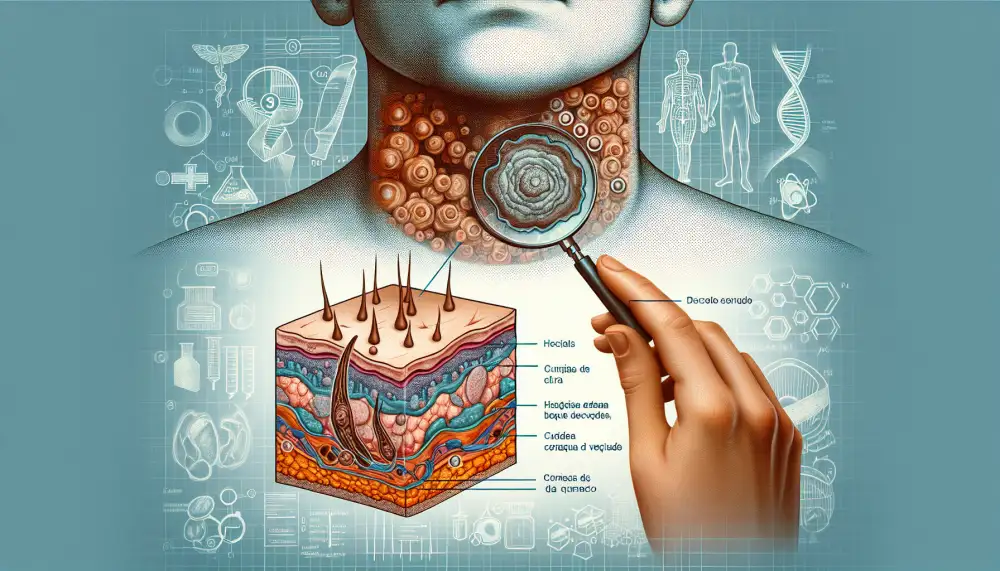
While these measures can significantly reduce your risk, they don't guarantee complete protection. If you notice any unusual growths on your neck, consult a dermatologist for proper diagnosis and treatment.
Maintaining Good Hygiene: Crucial for Prevention
Maintaining good hygiene is crucial in preventing the spread of the human papillomavirus (HPV), which is the primary cause of warts. HPV is highly contagious and can be easily transmitted through direct contact with infected skin or surfaces.
By practicing good hygiene habits, you can significantly reduce your risk of contracting or spreading HPV, thus minimizing the likelihood of developing warts on the neck or any other part of your body. Wash your hands frequently with soap and water, especially after touching your neck or any potentially contaminated surfaces. Avoid sharing personal items such as towels, razors, or clothing, as these can harbor the virus.
If you have existing warts, refrain from picking or scratching them, as this can spread the virus to other parts of your body or to others. Keep your neck area clean and dry, as moisture can create a favorable environment for viral growth. If you have any concerns about warts or HPV, it is essential to consult a healthcare professional for proper diagnosis and treatment options.
Vaccination: Protecting Against HPV Strains
Warts on the neck, while often harmless, can be a nuisance. These small, rough growths are caused by the human papillomavirus (HPV), a common virus with many different strains. Some HPV strains cause warts on the hands and feet, while others are responsible for those appearing on the neck. HPV spreads through skin-to-skin contact, and you can even contract it by sharing personal items like towels or razors.
While not all HPV strains lead to warts on the neck, vaccination can offer protection. The HPV vaccine protects against the most common strains that cause cervical cancer and genital warts, and some of these strains can also cause neck warts. Getting the HPV vaccine can significantly reduce your risk of developing these warts.
It's important to remember that warts, including those on the neck, can be spread even if they are not visible. Practicing good hygiene, like frequent handwashing and avoiding contact with other people's warts, can also help prevent their spread. If you're concerned about warts on your neck or anywhere else, consult a healthcare professional for proper diagnosis and treatment options.
Boosting Immunity: Lowering Your Risk
While the appearance of warts, including those on the neck, is primarily linked to the human papillomavirus (HPV), a weakened immune system can increase your risk. When your body's defenses are low, it becomes easier for HPV to take hold and cause these skin growths.
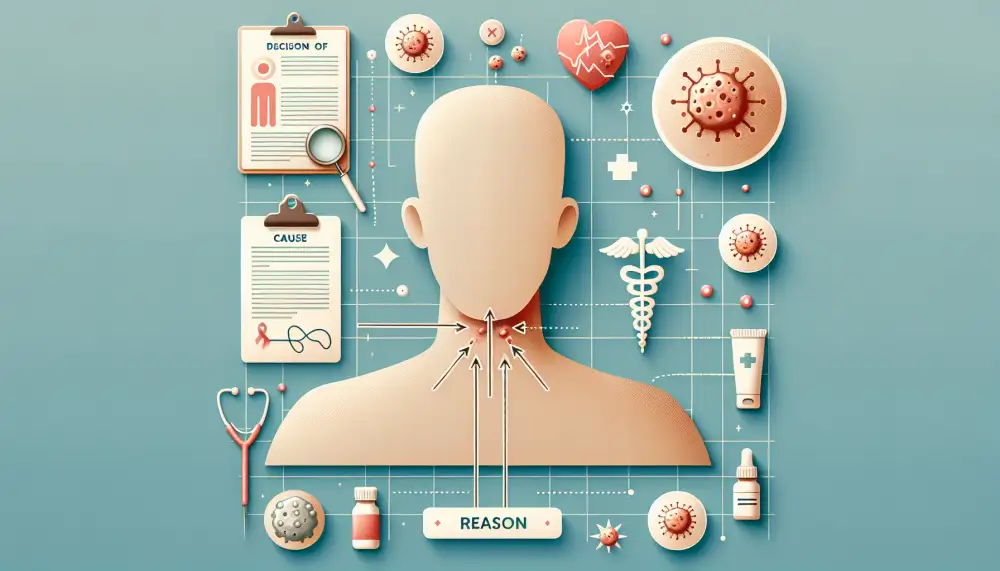
So, how can you bolster your immunity to lower your risk?
Prioritize a healthy lifestyle: A balanced diet rich in fruits, vegetables, and whole grains provides essential nutrients. Regular exercise strengthens your immune system. Adequate sleep allows your body to repair and regenerate.
Manage stress: Chronic stress weakens the immune response. Explore stress-reduction techniques like yoga, meditation, or spending time in nature.
Don't smoke: Smoking compromises the immune system, making you more susceptible to infections, including HPV.
Limit alcohol consumption: Excessive alcohol intake can suppress immune function.
Practice good hygiene: Wash your hands frequently with soap and water, especially after using public restrooms or touching surfaces that may harbor germs. Avoid touching your face unnecessarily.
Remember, while these strategies can support your immune system, they don't guarantee complete protection against HPV or warts. If you have concerns about skin growths or your risk of HPV infection, consult a healthcare professional.
Published: 30. 06. 2024
Category: Food



